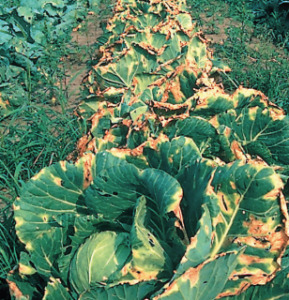Black rot is a serious fungal disease that primarily affects plants in the Brassicaceae family, such as cabbage, broccoli, cauliflower, kale, and other cruciferous vegetables. This disease can cause significant damage to crops, leading to reduced yields and even complete crop loss if not properly managed. In this article, we’ll explore what black rot is, how it spreads, its symptoms, and the best practices for prevention and control.
What is Black Rot?
It is caused by the bacterium Xanthomonas campestris pv. campestris. The disease gets its name from the characteristic black, V-shaped lesions that appear on the leaves of infected plants. As the disease progresses, it can spread to the stems and roots, causing the entire plant to wilt and die. It is particularly destructive in warm, humid climates and can spread rapidly through a field or garden if not controlled.
How Does it Spread?
Ii spreads primarily through infected seeds, transplants, and plant debris. The bacterium can also be transmitted by splashing water, such as rain or overhead irrigation, and by insects that feed on the plants. Once the bacterium enters a plant, it moves through the vascular system, clogging it and causing the characteristic symptoms of the disease.
Environmental conditions play a significant role in the spread of this disease. Warm temperatures (75-95°F) and high humidity create ideal conditions for the bacterium to thrive and spread. Poor air circulation and overcrowded plantings can also exacerbate the spread of it.
Symptoms of Black Rot
Recognizing the symptoms, it can be prevented. The most common symptoms include:
- V-shaped Lesions: One of the earliest signs of it is the appearance of V-shaped, yellow-to-brown lesions on the edges of leaves, with the point of the V facing the center of the leaf.
- Black Veins: As the disease progresses, the veins within the affected areas turn black, which is a hallmark of black rot.
- Wilting and Leaf Drop: Infected leaves may wilt, turn brown, and drop off the plant. This is particularly common in hot, dry conditions.
- Stunted Growth: Plants infected with black rot often exhibit stunted growth and reduced vigor, leading to poor yields.
- Stem and Root Decay: In severe cases, the bacterium can spread to the stems and roots, causing the entire plant to wilt and die.

Prevention
Prevention is the most effective way to manage black rot, as there are limited options for controlling the disease once it has established itself. Here are some strategies to prevent black rot:
- Use Disease-Free Seeds and Transplants: Start with certified disease-free seeds and transplants to minimize the risk of introducing black rot into your garden or field.
- Crop Rotation: Practice crop rotation by avoiding planting cruciferous vegetables in the same location year after year. This helps break the disease cycle and reduces the likelihood of black rot outbreaks.
- Sanitize Tools and Equipment: Regularly sanitize tools, equipment, and containers to prevent the spread of the bacterium. This is especially important if you have previously dealt with black rot in your garden.
- Proper Spacing and Air Circulation: Space plants appropriately to allow for good air circulation, which helps reduce humidity levels around the plants. Avoid overcrowding, as dense plantings can create an environment conducive to black rot.
- Watering Practices: Water plants at the base rather than overhead to minimize leaf wetness, which can promote the spread of Cabbage Rot. Early morning watering is best, as it allows plants to dry off before nightfall.
- Remove and Destroy Infected Plants: If you notice any plants showing symptoms of black rot, remove and destroy them immediately to prevent the disease from spreading to healthy plants.
Treatment
If it is detected in your garden or field, there are several steps you can take to manage and control the disease:
- Copper-Based Fungicides: While there is no cure for black rot, copper-based fungicides can help suppress the spread of the disease. Apply fungicides according to the manufacturer’s instructions and reapply as necessary, especially after rain.
- Biological Control: Some beneficial bacteria and fungi can help suppress black rot by outcompeting or inhibiting the growth of Xanthomonas campestris. Products containing Bacillus subtilis or Trichoderma species can be applied to the soil or plants to help reduce the severity of the disease.
- Remove Plant Debris: At the end of the growing season, remove and destroy all plant debris from the garden or field. Black rot bacteria can survive in plant debris and soil, so it’s important to eliminate any potential sources of infection.
- Rotate Crops: If it has been a problem in your garden, avoid planting cruciferous vegetables in the same area for at least three years. This will help reduce the bacterial population in the soil.
- Monitor and Act Quickly: Regularly inspect your plants for early signs. If you spot symptoms, take immediate action to prevent the disease from spreading.
Conclusion
Black rot is a challenging disease that can have devastating effects on cruciferous vegetables. However, with proper prevention and management strategies, you can protect your garden or field from this destructive pathogen. By using disease-free seeds, practicing good garden hygiene, and being vigilant in monitoring your plants, you can reduce the risk of black rot and ensure a healthy, productive harvest.
Early detection and prompt action are key to controlling black rot. Stay proactive, and you’ll be well-equipped to manage this disease and keep your garden thriving.
